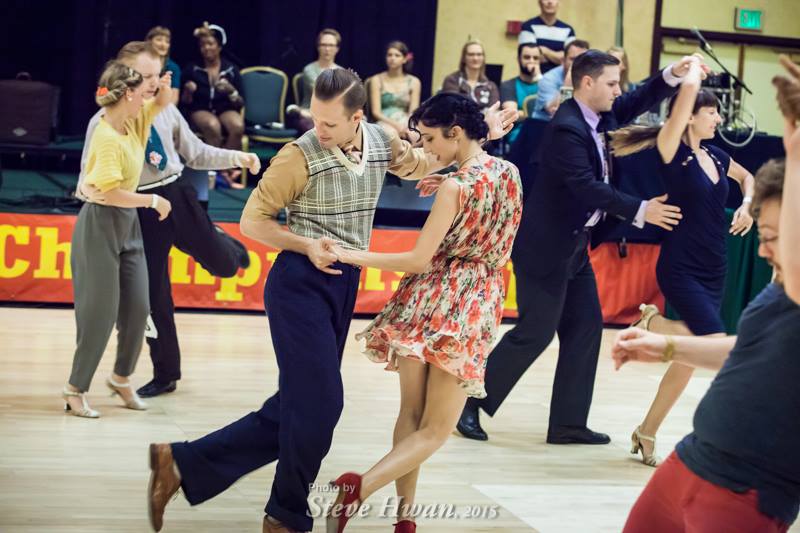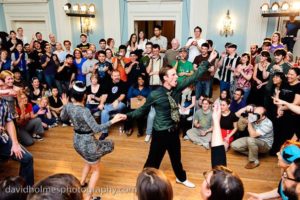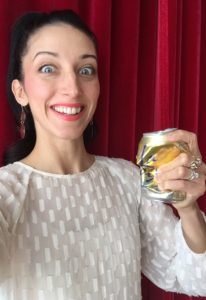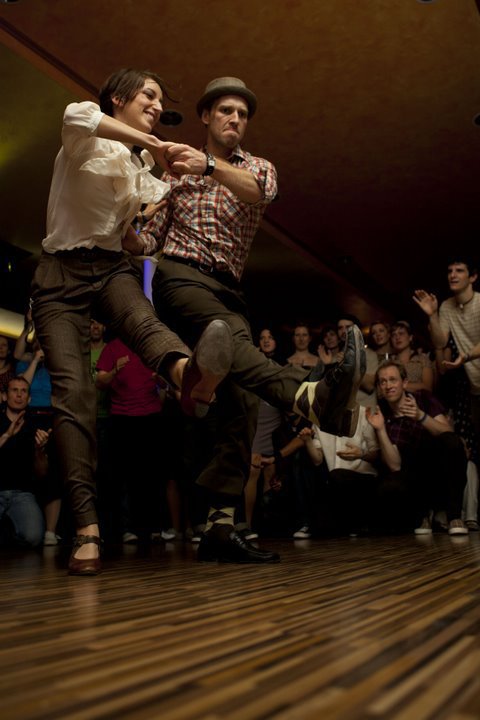![]() "Every year it is something different! You change so much we can barely keep up!”
"Every year it is something different! You change so much we can barely keep up!”

I want to show my students, no matter how much you improve you never stop growing. When I look at the past 8 years of my partnership with Dax, one thing has never changed, and that is our core focus: the pursuit of better dancing. Our priorities switch as we research and explore ways to improve to grow and expand. With every new focus, we dive deeper, thus adding more layers of awareness and information to our ideas. We are not different than we were 8 years ago. We are more than we were 8 years ago.
The Beginning With Dax
[caption id="attachment_14278" align="alignleft" width="300"]

Me trying to pretend I knew what I was doing > Lonestar 2010 (shot by David Holmes)[/caption]
When I first started training with Dax, he had been finishing his last teaching cycle with Alice Mei. Together, they had built an empire of teaching methods and ideologies. At the time, I had been swing dancing for many years but didn't train much seriously*. I lived blissfully in the world of a social dancer, not knowing much technically but having fun with my natural talents (Here is a video example of me at this time rockin it with Shesha (Atomic Ballroom, California). After spending two weeks in "boot camp" with Dax in Montreal, I was utterly floored at how much I didn't know. Shortly after this (and after agreeing to be Dax's dance partner), I went home where I had one month to catch up on his and Alice's ideas before returning to Montreal. I had two months until my first international teaching gig. I felt an immense rush to learn all that Alice had helped to build so I could pull my weight and prove myself as a new teacher (impossible, but a goal nonetheless). I studied every video here on Rhythmjuice, learned every routine, to be as best prepared as possible.
New Ideas
During this time, I was introduced to a basic idea about body movement and
body leading vs arm leading (see example below or lollies done in these two different schools of thought)
https://vimeo.com/216919958
Dax was big on body matching with a focus on footwork matching at that time.
Meaning, when your body is fully engaged (like how a bicycle's wheels are connected via gears and chains and everything works together) ...
... the leader can tell the follower exactly how to move and what footwork to use. I also was introduced to the matching of body tension (versus matching shapes) and the idea of excess tension (or rather, the idea of how to get rid of it).
[caption id="attachment_14269" align="alignleft" width="229"]

Excess Tension...you don't need to crush the can to hold it up[/caption]
It took two frustrating years for these concepts to fully settle with me and one more year before I started to feel like I owned these ideas enough to help Dax form a new empire of ideologies with me.
Before accepting these new concepts, I was blissfully naive. I was ballsy when I danced (not a bad thing). I thought being a good follower was about doing as much as possible (especially in contests or level testings). After embarking on this new path, I felt like my creativity focus was distracting me from learning these new concepts. So I put my own creative growth on hold and for the next three years and was devoted to becoming as technically advanced as possible. I wanted to be a follower that not only followed directions but followed body movements. I cared deeply about how I felt to the leader. I wanted to be fast and accurately react to signals from my leader. I wanted to hold a partner's hand and know everything about their technique within the first 10 seconds of a dance. I wanted as many tools as I could to feel empowered. I will tell you a few things about this path:
I succeeded in my goals...and it was stressful.
![]()
The Breakthrough
[caption id="attachment_14279" align="alignleft" width="339"]

Lindy Shock Budapest, 2010[/caption]
Things clicked (finally!) and I started to feel wise and powerful. I had a deeper understanding of the technical side of following.
With this, I also felt overworked on the dance floor. I had to work a million times harder to achieve a high-quality dance with a bad leader because I got so good at receiving information, it was hard for me to ignore bad information.
I felt super boring. When I had a leader that was more about disconnecting and jamming with the music or putting me on the spot to do something, I felt like I had nothing to offer. I could finally follow Dax's exact footwork, but only with immense concentration.
With these struggles and achievements, my dance conversations started to go deeper with Dax. Our mentorship transformed into a partnership, and we lived in this state comfortably for about a year before things evolved.
Dax has always appealed to those who want to take their dancing to the professional or competitive levels because these tools can get you there, which was a differentiator in our teaching strategy.
However, we realized most people just want to be good social dancers. Putting everything aside, social dancing is the end game. It's the soul of this dance and the way we viewed the dance needed to be focused on that.
Body Matching
We needed to hone in on the Body Matching term. Matching footwork was a fancy skill to have but totally not necessary for the social dance floor (at least for how deep we took it) and was too restricting. What is way more powerful is matching body movement (what happens in the core area). For every core body movement, there are hundreds of complimentary footwork options.
This made us feel more like a unit. Our core movements felt connected but we could improvise everywhere else! My stress was lifted. I felt less pressure to be exact in my following and once I switched my focus from feet to body, things progressed much faster.
Going Solo(Sort Of)
This stage lasted about a year for us, and during that time, we geeked out hard. The solo jazz trend was taking off. Teachers were catching onto the idea that if you wanted to become a better swing dancer then you had to learn to solo dance: The better you moved your own body, the better you could move with someone else. And we agreed – mostly. There is Authentic Jazz and for us, there are specific movements one does solo that works for partnering. Watch Dax below show an example of each.
These are two very different focuses when solo training (although they complement each other). We began teaching our class with this focus. If we were teaching a tuck turn, students would practice the solo movements for the first half of class. The more we saw the solo movement in each variation (the intention behind each partnered dynamic), it became more clear. When we discovered the legitimate, beautiful flow of solo movement that creates a swing out, our minds were blown. I could take an entire partnered routine and dance it solo, making it an awesome jazz routine. This inspired our Solo Body Movement course on RhythmJuice. You can also find this concept in the Swingin' Solo portion of our Challenge of the Month Lessons and is now integrated into all our new programs. Recognizing that body movement is the hardest thing to work on, we struggled to teach these ideas in workshops. We can change someone's mind pretty quickly, but it takes a long time to change their physical habits and muscle memory. Our classes were too difficult for most.
We streamlined. We removed old exercises that were good but not applicable enough to our social dancing goals.
Fostering Environments vs. Taking Control
Once we understood how our body movements affect our partnering, another conceptual question surfaced: Who is really leading? I love being on the follower side of the dance but I also want to be equal in making the decisions of how the dance goes. Honestly, I have always had a distaste for the words “leader” and “follower.” As we became more focused on excellent body movement as a primary goal, we started trying new approaches that would help each of us move better without losing the detailed communication that we have worked so hard to develop. It really started with the swivels, as Dax started teaching leaders not to lead/make the girls swivel
.
Instead, he emphasized the idea of setting up an environment that encourages the follower to swivel, supporting them to look their best!
As a follower, I LOVED how good these words made me feel. If leading/following was less about controlling the other person and more about setting up environments that encourage a certain dynamic or movement, can't I do the same to influence the leader? And how far can I take it?
Musicality
While this concept of creating ideal environments gave a radical new definition to the label "follower," we still needed to get back to our core question: "What are the skills that people want to maximize their social dance experience?" We tried a lot of stuff and found that nothing added value like musicality and rhythm. There was such a large reward for a musical moment compared to a moment where you move well, do a cool variation, or lead/follow clearly. It was so much more tangible and we discovered that it got more people excited about dancing because they could quickly experience the benefits without changing their body's habits.
While some dancers like to create music with their bodies on top of the music playing, we wanted to make music with our bodies that represented the music being played as our main focus.
We explored adding to the music and exactly representing the music being played. We tried hitting the same stuff together, and different parts separately. We started to model our partner dancing off the band concept. A group of individuals working different things together in harmony.
We played with concepts like "
same footwork, different rhythm" ...
and "same rhythm, different footwork".
We created a complete system for learning syncopation so students could easily do the same thing without getting overwhelmed. It included the rock step and triple step variations we felt were the most useful and gave the most options to represent the music.
And when you put the music as top priority
, adjusting starts to become a more helpful tool than matching
.
I got hooked on this feeling.
I had spent 4 years just "following," and I was ready to be “selfish.” The music and I decided to have an affair. As we built our musicality, I learned what it feels like to "see red" while social dancing. I got so experimental that I either freaked out my leader or sometimes freaked myself out.
I started to care less about the exactness of my following and wanted to just DANCE. You might think I harbored regret after all the stress I put myself through leading up to this, but I have no regrets. My technique became so ingrained into my dancing. My muscle memory is so strong now that even when I am paying no attention to the leader and experimenting like crazy, my response time is now sharper than ever because I'm less stressed. Relaxed muscles and a calm mind help you respond faster and smarter. I don’t know if this would be possible without the 4 years of training body movement and body matching, but now I feel like I can freely express the music without a negative impact on my following.
Purposeful Execution
This has led me to the current stage: Purposeful Execution. There is a fine line between a clear musical idea and a musical spasm. As Dax says to our beginners, “You gotta make a mess before you can clean up!” It is so true, and I feel like it is time to clean up the mess. I have spent the last year being pretty experimental and selfish and it’s time to focus on impact. I want to get better at making good decisions that stand out. The tools are there, and it is just a matter of continually practicing and improving. This goes the same for my styling. I want to be applying choices that are difficult enough to require training in a dance studio and not just created organically on the floor.
Flow
We opened a local studio a few years ago. This was the first we got to work with total beginners from the ground up. Wow! What a new type of relationship! It was clear that we needed a solid beginner program to thrive.
This led Dax to ask the question, "What are the most common and essential moves that all professional leaders actually do while dancing?" He spent days watching his own social demo videos. He watched other pros. But it really clicked when he started watching videos of people who have never taken dance lessons. Drunk people at a wedding or at a bar. He started to see patterns and realized it wasn't just common moves but actually certain combinations that kept occurring. It was like there was some other force at work beyond the leader’s ability to choose. He called these Natural Flows, and our goal was to lock down the essential ones to teach our beginners so we didn’t waste time on moves that weren’t beneficial.
As a follower, I wanted to join in on this topic. It turns out that I can equally influence flow and help maintain it. I realized that the way I move was responsible for creating a wonderful, fluid feeling while transitioning between moves. I could also fix moves that don’t naturally flow with the right body movements. Then I realized I could passively influence the leaders next choice by the way I completed the previous move (setting up that environment!).
Understanding flow has led to a lean curriculum that is really natural and easy to learn!
What’s Next
With every new stage, I feel like, This is it. Then something new reveals itself and causes us to totally rethink how all elements relate to each other.
What to join us on our journey?
Sign up today!
*While I say I never seriously trained, I DID have the privilege to work with/for a few great and talented leaders which I learned a lot. Big thanks to Todd Yannacone, Shesha Marvin and Doug Silton for believing in me.
**This whole Topic is meant for another blog post. It’s important to decide what your goals are and be honest with yourself. Most people don’t want to be “the best”, they just want to have a good social dance. Also, I think my path was especially stressful because of the expectations we put on ourselves at that time (matching exact footwork, etc.). I think if I took the same learning path but now, with our current views, it wouldn’t have been so stressful.
Written by Sarah Breck
Edited by Dax Hock and Alexis Justman
UPDATE!
Since writing this, our Flow concept has grown and involved even more. We have discovered the impact of knowing your POSITIONS. These are the main hubs you go through when you are flowing. They are essential to get on lock down when learning a new dance style, empowering your following or becoming a master at improv. Positions are a main part of our ESSENTIAL FLOW SYSTEM that is the base for all our new programs coming out this year. Stay tuned! We are excited!
![]() "Every year it is something different! You change so much we can barely keep up!”
"Every year it is something different! You change so much we can barely keep up!”
 Me trying to pretend I knew what I was doing > Lonestar 2010 (shot by David Holmes)[/caption]
When I first started training with Dax, he had been finishing his last teaching cycle with Alice Mei. Together, they had built an empire of teaching methods and ideologies. At the time, I had been swing dancing for many years but didn't train much seriously*. I lived blissfully in the world of a social dancer, not knowing much technically but having fun with my natural talents (Here is a video example of me at this time rockin it with Shesha (Atomic Ballroom, California). After spending two weeks in "boot camp" with Dax in Montreal, I was utterly floored at how much I didn't know. Shortly after this (and after agreeing to be Dax's dance partner), I went home where I had one month to catch up on his and Alice's ideas before returning to Montreal. I had two months until my first international teaching gig. I felt an immense rush to learn all that Alice had helped to build so I could pull my weight and prove myself as a new teacher (impossible, but a goal nonetheless). I studied every video here on Rhythmjuice, learned every routine, to be as best prepared as possible.
Me trying to pretend I knew what I was doing > Lonestar 2010 (shot by David Holmes)[/caption]
When I first started training with Dax, he had been finishing his last teaching cycle with Alice Mei. Together, they had built an empire of teaching methods and ideologies. At the time, I had been swing dancing for many years but didn't train much seriously*. I lived blissfully in the world of a social dancer, not knowing much technically but having fun with my natural talents (Here is a video example of me at this time rockin it with Shesha (Atomic Ballroom, California). After spending two weeks in "boot camp" with Dax in Montreal, I was utterly floored at how much I didn't know. Shortly after this (and after agreeing to be Dax's dance partner), I went home where I had one month to catch up on his and Alice's ideas before returning to Montreal. I had two months until my first international teaching gig. I felt an immense rush to learn all that Alice had helped to build so I could pull my weight and prove myself as a new teacher (impossible, but a goal nonetheless). I studied every video here on Rhythmjuice, learned every routine, to be as best prepared as possible.
 Excess Tension...you don't need to crush the can to hold it up[/caption]
It took two frustrating years for these concepts to fully settle with me and one more year before I started to feel like I owned these ideas enough to help Dax form a new empire of ideologies with me.
Before accepting these new concepts, I was blissfully naive. I was ballsy when I danced (not a bad thing). I thought being a good follower was about doing as much as possible (especially in contests or level testings). After embarking on this new path, I felt like my creativity focus was distracting me from learning these new concepts. So I put my own creative growth on hold and for the next three years and was devoted to becoming as technically advanced as possible. I wanted to be a follower that not only followed directions but followed body movements. I cared deeply about how I felt to the leader. I wanted to be fast and accurately react to signals from my leader. I wanted to hold a partner's hand and know everything about their technique within the first 10 seconds of a dance. I wanted as many tools as I could to feel empowered. I will tell you a few things about this path:
Excess Tension...you don't need to crush the can to hold it up[/caption]
It took two frustrating years for these concepts to fully settle with me and one more year before I started to feel like I owned these ideas enough to help Dax form a new empire of ideologies with me.
Before accepting these new concepts, I was blissfully naive. I was ballsy when I danced (not a bad thing). I thought being a good follower was about doing as much as possible (especially in contests or level testings). After embarking on this new path, I felt like my creativity focus was distracting me from learning these new concepts. So I put my own creative growth on hold and for the next three years and was devoted to becoming as technically advanced as possible. I wanted to be a follower that not only followed directions but followed body movements. I cared deeply about how I felt to the leader. I wanted to be fast and accurately react to signals from my leader. I wanted to hold a partner's hand and know everything about their technique within the first 10 seconds of a dance. I wanted as many tools as I could to feel empowered. I will tell you a few things about this path: I succeeded in my goals...and it was stressful.
I succeeded in my goals...and it was stressful. Lindy Shock Budapest, 2010[/caption]
Things clicked (finally!) and I started to feel wise and powerful. I had a deeper understanding of the technical side of following.
With this, I also felt overworked on the dance floor. I had to work a million times harder to achieve a high-quality dance with a bad leader because I got so good at receiving information, it was hard for me to ignore bad information.
I felt super boring. When I had a leader that was more about disconnecting and jamming with the music or putting me on the spot to do something, I felt like I had nothing to offer. I could finally follow Dax's exact footwork, but only with immense concentration.
With these struggles and achievements, my dance conversations started to go deeper with Dax. Our mentorship transformed into a partnership, and we lived in this state comfortably for about a year before things evolved.
Dax has always appealed to those who want to take their dancing to the professional or competitive levels because these tools can get you there, which was a differentiator in our teaching strategy.
However, we realized most people just want to be good social dancers. Putting everything aside, social dancing is the end game. It's the soul of this dance and the way we viewed the dance needed to be focused on that.
Lindy Shock Budapest, 2010[/caption]
Things clicked (finally!) and I started to feel wise and powerful. I had a deeper understanding of the technical side of following.
With this, I also felt overworked on the dance floor. I had to work a million times harder to achieve a high-quality dance with a bad leader because I got so good at receiving information, it was hard for me to ignore bad information.
I felt super boring. When I had a leader that was more about disconnecting and jamming with the music or putting me on the spot to do something, I felt like I had nothing to offer. I could finally follow Dax's exact footwork, but only with immense concentration.
With these struggles and achievements, my dance conversations started to go deeper with Dax. Our mentorship transformed into a partnership, and we lived in this state comfortably for about a year before things evolved.
Dax has always appealed to those who want to take their dancing to the professional or competitive levels because these tools can get you there, which was a differentiator in our teaching strategy.
However, we realized most people just want to be good social dancers. Putting everything aside, social dancing is the end game. It's the soul of this dance and the way we viewed the dance needed to be focused on that.

Comments